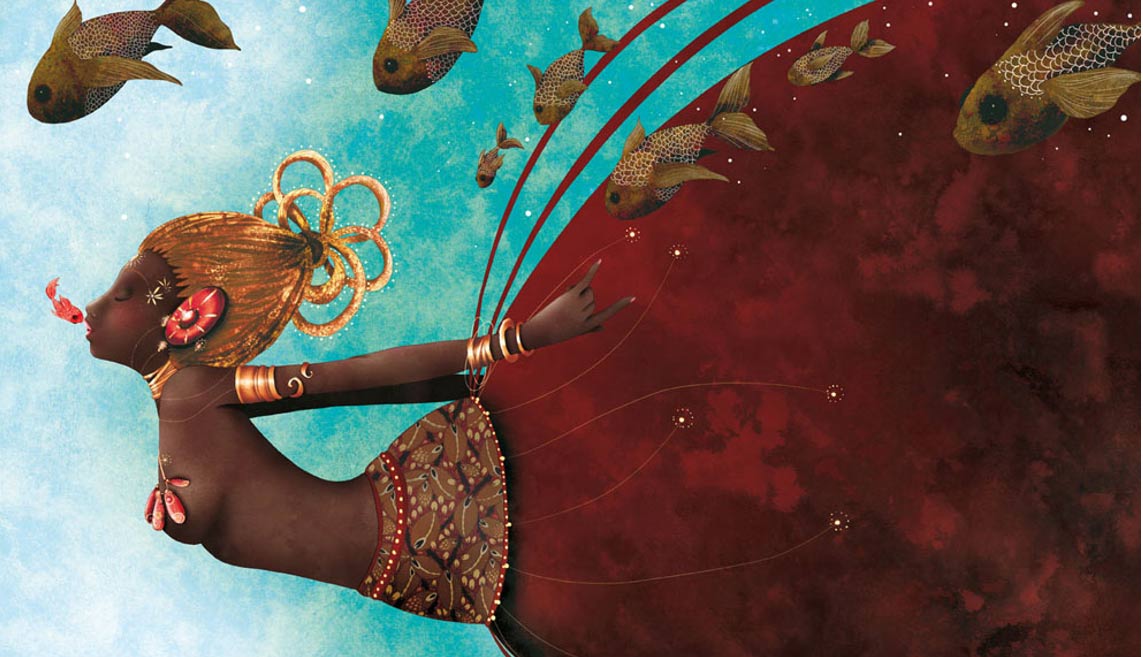Reading Time: 5 minutes
The Osun-Osogbo Sacred Grove is situated along the Osun River in the city of Osogbo and is a UNESCO world heritage site. Here, a statue of the goddess Osun stands by the river with her arms outstretched as if to welcome visitors to her forest. Since ancient times, worshippers arrive at the Osun sacred grounds to present their prayers and offerings to Osun – the goddess of rivers, fertility, sexuality, prosperity and love, says Radhika, tracing the oral traditions and ancient rituals. A Different Truths exclusive for the Africa Special Issue.

There is a need for a new kind of story, one which is also ancient in its roots, one whispered by the Yoruba women to their daughters and granddaughters, one which travelled across the Atlantic waters with the catastrophic mass enslavement of the men and women of Nigeria.
A story that reminds the once oppressed people of their power and beauty, one that reinstates our oneness with nature, that speaks more of our inner worlds rather than the outer, a story that can bring back the magic needed to heal our damaged planet, a story of ancient forests, of a fierce river goddess that flew over sacred groves, invoking our most primal fears and reverence.
The Osun-Osogbo Sacred Grove is situated along the Osun River in the city of Osogbo and is a UNESCO world heritage site. Here, a statue of the goddess Osun stands by the river with her arms outstretched as if to welcome visitors to her forest. Since ancient times, worshippers arrive at the Osun sacred grounds to present their prayers and offerings to Osun – the goddess of rivers, fertility, sexuality, prosperity and love.
The indigenous Yoruba people of the region tell a story of the initial settlers from the area who were cutting down a tree from the sacred grove when a voice arose from the river, instructing them to stop and move away. It was the voice of Osun, who lived in the river. The settlers left the site for higher ground, establishing what would become the city of Osogbo, 400 years ago, and dedicated the forest to the goddess. Every August, thousands come to the city for the Osun Festival and to celebrate the special pact between the Osogbo people and the Yoruba goddess.
A sacred grove is any grove of trees that is of special religious value to a particular culture or community. Sacred groves feature in various cultures throughout the world. There are many traditional activities that have been used to protect the Osun-Osogbo site, such as traditional laws, myths, taboos and customs that forbid people from fishing, hunting, poaching, felling of trees and farming. The Grove is also a natural herbal pharmacy containing over 400 species of plants, some endemic, of which more than 200 species are known for their medicinal uses.
A century ago there were many sacred groves in Yorubaland: every town had one. Most of these groves have now been abandoned or have shrunk to quite small areas
The different facets of goddess Osun flow into each other and rise naturally to the surface much like the river she embodies. Devotion to Osun also makes explicit, the implicit powers of Yorbu women in social, economic and political spheres. Ironically it was a woman who helped resurrect the Osun-Osogbo shrine and sacred grove in the mid-1950s after its destruction, reaffirming the goddess’s teachings.
According to Yorbu religious texts, Ọṣhun was the only female primordial spirit sent by god to create the world. The other spirits that were sent initiated the task and disregarded Ọṣun. Ọṣun gathered the womenfolk together and objected to the deliberate disrespect by forming Iyami Aje, a band of women gifted with special power. The male spirits failed repeatedly at their work and when they questioned god of why they weren’t succeeding, god informed them that they couldn’t succeed without seeking Ọṣun’s help and that anything they may attempt to do without women will fail. Upon hearing this, the male spirits rushed to beseech Ọṣun to help them.
In the early 20th century following the advent of other religions, the British colonial rule in Nigeria and the deliberate breakdown of Yorbu culture and religion, the Osogbo forest’s artifacts were pillaged and wrecked. Most of the ancient sculptures were destroyed in this period. Trees were clear-felled for agriculture, teak plantations established, and hunting and fishing – previously forbidden in the sacred Grove – flourished.
It was in the 1950s that Austrian-born female artist Suzanne Wenger moved to Osogbo with her husband. With the backing from the local community and priests, she formed the New Sacred Art Movement to challenge land mafia, discourage hunters, defend the shrines and begin on the long route of bringing the sacred forest and shrines back to their former glory. Suzanne and her artists intentionally fashioned enormous, immovable figurines in iron, cement and mud to help protect the forest and stop thefts. The sculptures were created with respect for the spirit of the Grove and were inspired by Yoruba mythology. In 1965, the Grove was declared a national treasure. The Grove was named a UNESCO World Heritage Cultural Site in 2005. The Osun-Osogbo Grove is a symbol of African heritage and is a means of sharing traditional religion and indigenous knowledge systems with the people of the African Diaspora.
Comparable to the destruction of the Sacred grove of Oshun was also the oppression of the Yorbu people due to the trans-atlantic slave trade. The Yoruba people, among the most heavily targeted, contributed significant cultural and economic influence upon the Atlantic slave trade during its run from approximately 1400 until 1900 CE. However, from the forests of Osogbo, to the slave ships, to the streets Brazil and Cuba, Oshun created ways to express herself and create hope across cultures and nationalities for Afro-Americans and Yorbu people striving to make both physical and spiritual space for themselves.
Testimony to Osun’s influence spreading as part of the salve trade across waters and continents are the distinctive drums for Osun in Cuban folkloric music that sound distinctive rhythms for her worship. And similarly dedicated rhythms were also the most visible expressions of a reassertion of Afro-Brazilian identity in the 1970 and it is a consonant of Osun’s power to find her the pulse of what might be called the “black pride” movement of Brazil and Cuba.
In addition to the influence on slavery, and later Afro-American cuisine and language, the importation of Yoruba culture was most heavily evidenced in such manifestations of Yoruba religion as Santería, Candomblé Ketu, and other traditional spiritualities. The saga of the Yorbu people and their struggle is irrevocably interwoven with that of the river goddess Osun and her shrine in Osogbo
Eventually, the stories we live by, that we tell ourselves and our children to explain the world — have consequences both personal and societal. They fill our imagination and provide counter narratives to give the kids critical perspective on what’s right and what’s wrong.
In recognition of the present day environmental and humanitarian perils facing our planet, we require a re-evaluation of the central aspects of our materialistic and egoistic culture as we move towards a way of life that is in harmony with the earth as a living whole, a culture that cares for the soul as well as the soil. There is a need to retell Osun’s story to our children, stories of our wild nature, of the same allurement rising in monarch butterflies, cranes and salmon retracing their ancestral paths across the planet as that of the Yorubo people retracing their roots to Osogbo every year. So we must pay heed once again to Oshun’s call. Calling us inwards, drawing us back again to the precise blend of memory, wind and rock and water where the wild is no longer alien and frightening but beautiful.
Prayer to Goddess Oshun : Oshun, oyeyeni mo… Oshun who is full of understanding, Ore yeye o… Most gracious mother. Onikii, amo-awo maro… Onikii, who knows the secret of cults but does not disclose them. Yeye onikii, obalodo… The gracious mother, the queen of the river. O san rere o….We sing your praise.
Photos from the Internet
#Oshun #RiverGoddess #Myth #Folklore #Africa #AfricanOralTradition #SpecialFeature #DifferetTruths

















Outstanding article covering mythology, history, slavery and finally the recognition of UNESCO. The article reminds me that behind some myths there are always lessons or warnings from ancient wisdom.
Regards